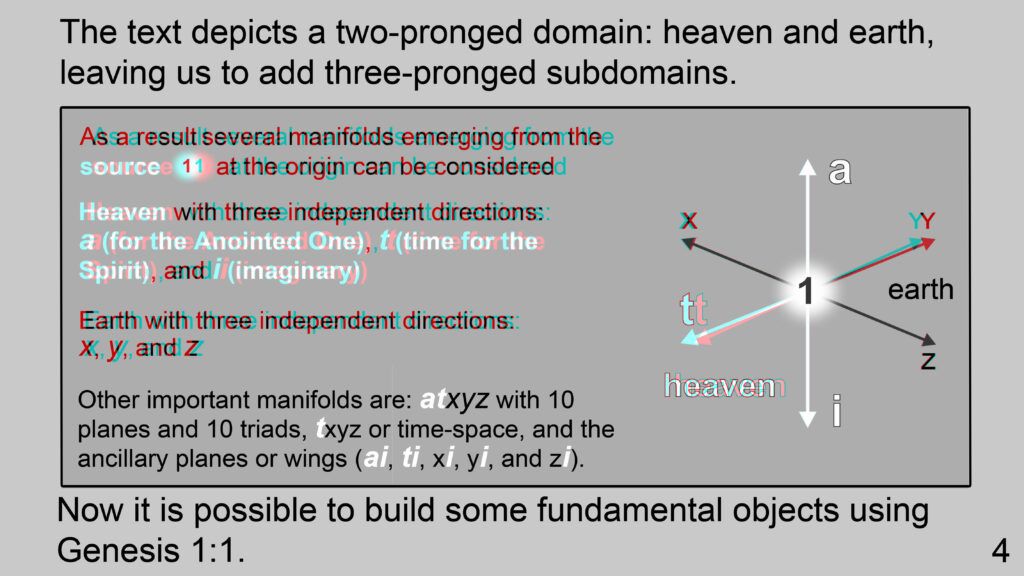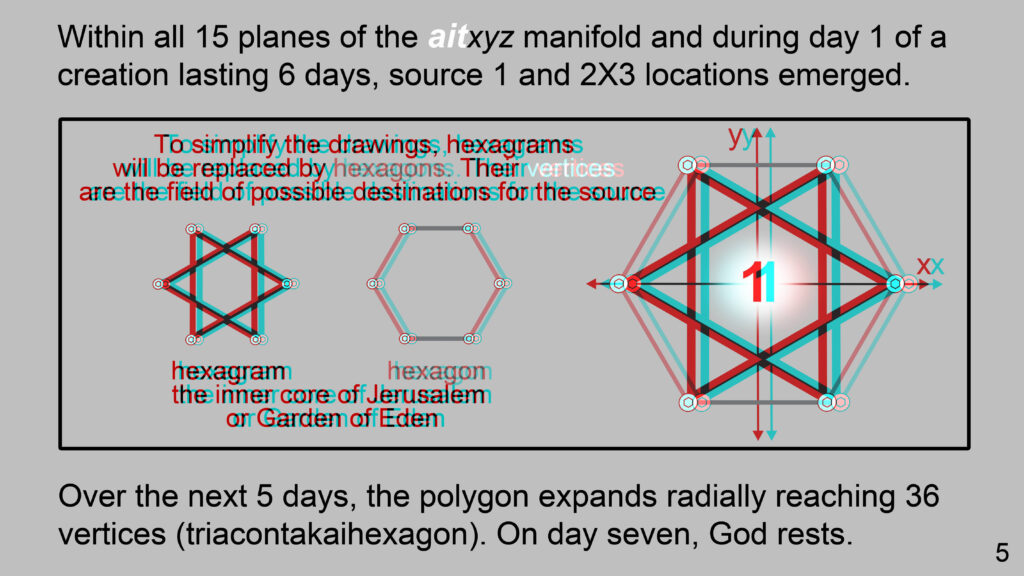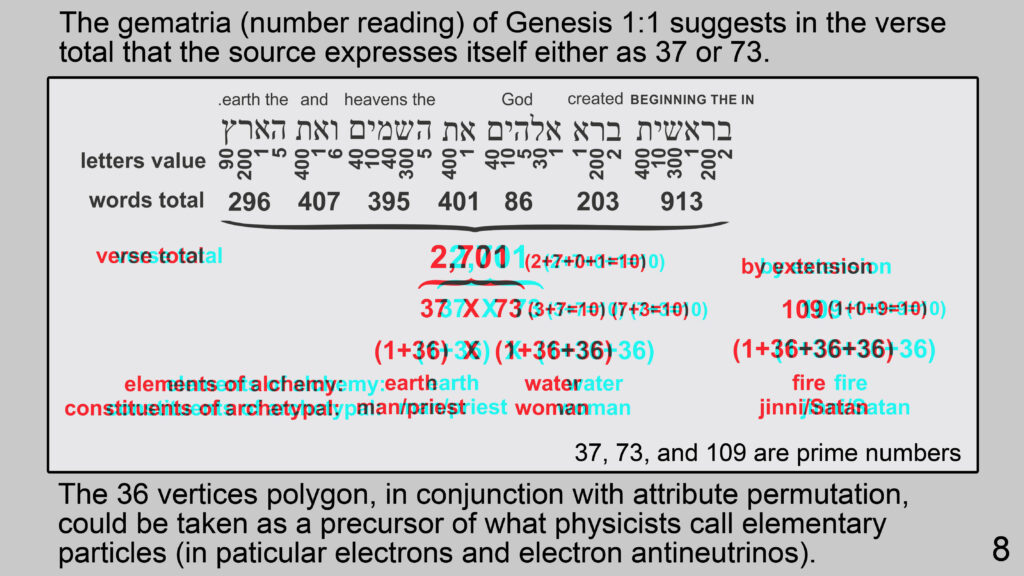
This essay on number 7 intends to introduce a new way of thinking on the controversial subjects of alchemy, angel wings, cubic shrines, and the physics of free will. The presentations depart from a religious perspective to explore their possible scientific implications, always in terms accessible to the lay reader. Topics previously mentioned are available on the top 2D and 3D Stereo menus.
In the Abrahamic religious tradition, the number 7 has unparalleled importance, only surpassed by number 1 reserved for God himself. It appears hundreds of times in the Hebrew Bible, and together with the numbers 3, 10, and 12 belongs to the select group of numbers representing the accomplishment of some perfections.
However, number 7 had crucial importance within the religious and the sacred, well before the Hebrew Bible was written. Notorious examples abound, all along with the geographical dispersion of the Kurgan culture (4000 BC) to the Far East, India, Mesopotamia, and Western Europe.
It is, though, surprising that a precise and concrete definition of its deepest meaning has been a well-kept secret. In stark contrast, vague and empty statements have become as abundant as everyone’s guess.
One of the few concrete uses of number 7 was in Egypt, where it served as the basis for the definition of the royal cubit, the unit of measure for the construction of “almost everything.”

The 4 great religions of the Fertile Crescent—Judaism, Zoroastrianism, Christianism, and Islam—begin Creation with a formula based on the number 7.
The Sacred Scriptures of Judaism, for example, start with a verse consisting of 7 words that are devoted to the very beginning of everything. The word in the middle of the sentence has no meaning. Creation unfolded for 7 days, the last of which God rested. In the Talmudic cosmogony, the creative process is called Ma’aseh Bereshit, where the word Bereshit refers to ב (bet), the first letter of the Bible.
The Zoroastrian Avesta has 7 Yasnas from XXXV to XLI—called the Haptangaithi—devoted to the unfolding of a divine heptad proceeding from Ahura Mazda and headed by Spenta Mainyu, the creative spirit. In later Persian texts, some of the 7 Amesha Spentas correspond to the primordial elements.
In the Christian Scriptures, most notably the Book of Revelation of John, the number 7 appears more than fifty times. In each of these appearances, number 7 describes the most notorious traits of God’s presence, manifestations, and acts. Regarding God´s first manifestation, the most eloquent account portrays God seated on his throne, and before him, 7 lamps are blazing, which are the 7 spirits of God.
The “Al-Fatiha” surah opening the Koran has 7 ayat (verses), the first 4 dedicated to the names of God. The “Al-Nur” surah mentions 7 times the word light (nur) and says explicitly: “Allah is the Light of the heavens and the earth.”

Looking into some detail, Genesis 1:1 reveals a structure. Not all summands within number 7 are of the same kind; the number 1 stands out. Subtracting 1 from the number 7 (a prime number), 6 is the remainder (a compound number).
The verse in question has a word formed with the first and last letter of the Hebrew alphabet את (tav alef) (gematria: 400 1), which has no meaning and will be considered the foremost one. This particular word would represent God as the source at every origin and as finality beyond the empyrean.
In the Book of Revelation 22:13 the same idea is expressed in terms of the first and last letters of the Greek alphabet αω (alpha omega) (isopsephy: 1 800): “I am the Alpha and the Omega, the First and the Last, the Beginning and the End.”

The text in the previous slide mentions 2 realms, earth and heaven, allowing the reader to interpret this in terms of 3 dimensions for each one to complete 6. In subsequent steps, the same model based on number 7—with 2 and 3-pronged subdomains (in a mathematical sense)—will repeat itself, again and again.
Subdomain earth is a region encompassed by three independent directions, commonly labeled x, y, and z, or in simpler terms, spatial length, width, and height. Heaven, though, is slightly harder to grasp. That is because biological human consciousness focuses on a point-like presence in this subdomain—as it happens in time at every instant called the present. The subdomain heaven has 3 independent directions: a, i, and t—perpetuity, imaginary, and time.
The direction a belongs to the Anointed Ones (one of whom is Christ, from the Greek Christós) mentioned in Zechariah 4:14: “So he said, ‘they represent the two Anointed Ones who stand by the Lord of the earth. ’” Direction i is ancillary to the other 5 and plays a decisive role in the mechanistic abstraction treated in the essay devoted to angel wings. The direction t is the proper time of matter (elementary particles) and the realm of the Holy Spirit, not to be confused with the time-like arrow of entropy (the aging of aggregates of matter).

The 6 independent directions constitute the aitxyz manifold with some interesting properties. The most relevant of them all has a connection with another numerical symbol of perfection, the number 10. Excluding direction i, the atxyz manifold groups 10 independent planes and 10 independent triads, which can be related to the 10 times the 3 words “and God said” appear in the creation account of the Book of Genesis (Genesis 1:3, 1:6, 1:9, 1:11, 1:14, 1:20, 1:24, 1:26, 1:29, and 2:18).
The simplest forms within the aitxyz manifold—besides the straight line—are the 10 planes in the atxyz manifold and the 5 ancillary planes where i participates. These 15 planes (15 = 5 × 1 + 5 × 2) may host a geometrical object, fitting perfectly with the gematria (Hebrew numerology) of Genesis 1:1 and the scheme of the six-day creation.
It all starts the first day of the six-day creation with the advent of the number 7 in the form of a hexagon or hexagram (not the unicursal one) emanating, as it were, from its source. With the source representing the Creator, the 6 vertices of the polygon are his possible new locations (a field). In mystical circles, the hexagram corresponds either to the Garden of Eden center or to the city of Jerusalem.
The hexagram was used by diverse cultures from the most remote antiquity in decorative figures or to symbolize some beliefs. It was already present in the Holy Land when Joshua entered. Archeology shows that its appearances in Hebrew culture over the centuries were not more profuse than in others. Its widespread use among the Hebrew people originated belatedly in a decree of Charles IV of Luxembourg, king of Germany and Bohemia, crowned emperor in Rome in AD 1355. This decree sought to identify the only properties allowed to the Jews in their quarter of Prague through a standard whose Hebrew origin is not known—probably its design was imposed as is often the case in similar circumstances.
From Prague, it passed to Vienna during the seventeenth century AD, and from there to Germany. During his stay in the Balkans, the Hebrew philosopher F. Rosenzweig adhered to the symbolism of the hexagram and used it as a source of inspiration for his Star of Redemption. Despite its popularity throughout Europe at the time, the hexagram was rejected by the most influential sectors of Hebrew orthodoxy.

But this is just the beginning of a polygonal expansion lasting 6 days, culminating with the formation of a triacontakaihexagon—36 vertices, the boundaries of both the Eden and Jerusalem. These boundaries are well known in mystical circles of the Abrahamic religions, because inside reigns the hidden (to us now) light, called in Hebrew Ohr HaGanuzh. The number 36 is of the utmost importance in Hebrew traditions, as in the symbolism of the 36 lights (excluding the Shamash) to celebrate the miracle of Chanukah.
During each of the 6 days, a single polygon is generated, and on day number 7, while God rests, 7 polygons are generated. The deployment sequence of the modular building blocks of creation is the same as for their antagonists (the antis, described on slide 7) before their mutual annihilation, as recounted in Joshua 6:3–4 for the assault on Jericho: “March around the city with all the men of war, circling the city one time. Do this for six days. Have seven priests carry trumpets of rams’ horns in front of the ark. On the seventh day, march around the city seven times, with the priests blowing the trumpets.” After day number 7, the polygonal expansion continues indefinitely, enlarging the field of possibilities to host the source.
The next video tries to incite the reader’s imagination on the expansive deployment of the field of possibilities. Following the suggestion of the Pesikta de-Rab Kahana (priska 20:7), we paraphrase by saying: "Jerusalem expands outward and rises upward until she reaches the throne of the glory of God,” beyond the empyreal vault. The Midrashic text interprets Isaiah (49:20): “The place is too strait for me: make room for me that I may dwell” and Ezekiel (41:7) on the temple: “And there were expanding windings still upwards on the sides thereof.” The spheres represent the infinite possible polygonal developments (in xyz), showing only one to avoid clutter.
The sexagesimal (base 60) (60 = 6 X 10) number system originated in Mesopotamia approximately 5,000 years ago and most likely led to the division of the circumference into 360 parts (we call degrees) (360 = 36 X 10). Both numbers point to the first and last polygons of the 6-day creation in the 10 planes of the atxyz manifold. They also simplify calculations by being highly composite: 60 is divisible by 12 integers and 360 by 24. Among the integers from 1 to 10, 60 is divisible by 1, 2, 3, 4, 5, 6, and 10, whereas 360 is divisible by all except 7.
In addition, there are sidereal considerations since the lunar year is a little less than 355 days, and the solar year is just a little more than 365, with 360 somewhere in between. The biennial period with its 730 days (730 = 73 X 10) also deserves some consideration, as slide 8 suggests. If the reader is interested in knowing how the hexagonal (36 = 6 × 6) and the square (36 = 4 × 9) representations of 36 relate to one another, go to slide 2 of the cubic shrines essay.

The progressive unfoldment of God’s immanent manifestation through the number 7 formula generates a second layer conditioning the first. The gematria of the word 1 of Genesis 1:1 את (tav alef), whose value is 401 (prime number), might reveal how. After subtracting 1 corresponding to the source, the remainder is 400 (400 = 4 × 10 × 10), suggesting a 4 conditioning upon the 10 planes and 10 triads of the atxyz manifold. Zeroth conditioning is the polygonal geometry playing the role of the source upon which 3 additional ones and their antis act as accidents.
The 3 accidents conditioning geometry are: charge the first one, rotation the second one, and color charge the third one—all of them with their antis and globally neutral or totaling zero in a physical sense. This triple conditioning is in close correspondence with the U(1), SU(2), and SU(3) gauge symmetries of the standard model of particle physics.

Genesis 1:1 verse total is 2,701, a very intriguing number resulting from the multiplication of 37 × 73, both prime numbers whose digits total is 10—the binary representations are 100101 for decimal 37 and the palindrome 1001001 for decimal 73. After subtracting 1 corresponding to the source, the remainders are 36 and 72 (72 = 2 × 36). The 1 to 2 proportion corresponds to the human archetype, as described in the essay on alchemy.
The biblical emphasis on the number 36 suggests that the corresponding polygon is directly associated with the notion of a building block for Creation. In religious terms, this is the closest we can get to the idea of a building block or precursor of what physicists call an elementary particle.
To complete the current interpretation of Genesis 1:1, as a description of some elementary particle, it is necessary to endow the series up to the tetracontakaidigon (forty-two [42 = 6 × 7] vertices and sides) generated on day number 7 with the 3 attributes mentioned in slide 7. However, at some point, the neutrality shown in slide 7 was lost in an unprecedented event fully developed through several chapters in the book Fundamentals of the Creation. As a result of such an event, the 3 attributes underwent a spatially local dislocation, and particles locally neutral up to that moment acquired charge, spin, and color charge.

So far, everything said deals with the static condition of elementary particles. Here, due to its complexity, we devote a single slide to their dynamic aspect. However, the subject is dealt with in more detail in essays dedicated to cubic shrines and angel wings. In this respect, the thing to have in mind is that particles don´t continuously displace in space. Instead, they transcribe from the origin, where they generate a field of possible locations, to their final destination within it.
The mediating agents in between are polygonal counterrotations taking place in ancillary planes in the corresponding direction. The ancillary planes ai, ti, xi, yi, and zi are called angel wings in the Sacred Scriptures. For example, within the triad xyz, there are 3 independent directions x, y, and z, but transcriptions occur from origin to destination in only 1—which might be a combination. Prophet Isaiah (Isaiah 6:2) refers to this fact, saying that although seraphim have 3 pairs of wings, they only use 1 to fly.

L. Massignon, the French Catholic scholar of Islam, concludes that for Muslim theologians, time is not continuous, but a constellation of instants, and space does not exist; there are only points. His conclusion follows inspiring ideas found in early Jain, Hindu, and Buddhist atomism as well as in Anaximander’s homoeomeries and Leucippus and Democritus’ atomisms.
As this essay on number 7 shows, Sacred Scriptures and religious literature suggest that reality contemplates uncountable independent objects made of meshes, each with an expanding number of vertices and segments/sides. Thankfully, science allows us to define the smallest distance between these vertices, the plank length, and time.
As a closing remark we may add that the Koran states 6+1 times, including God´s resting day: “created … the heavens and the earth … in six days” (The Heights: 54, Jonah:3, Hud:7, The Criterion:59, The Prostration:4, Qaf:38, and Iron:4).
The previous slides on number 7 are just but a small sample of what you will find in Fundamentals of the Creation. This book is a must-read for anyone wanting to understand the origins and meanings of the mysteries and symbols of religion and esotericism. If you enjoyed reading this post and want a comprehensive account of the role of numbers in creation, you should not miss...



Number 7´s 3D Stereo last update: April 27th, 2021.
